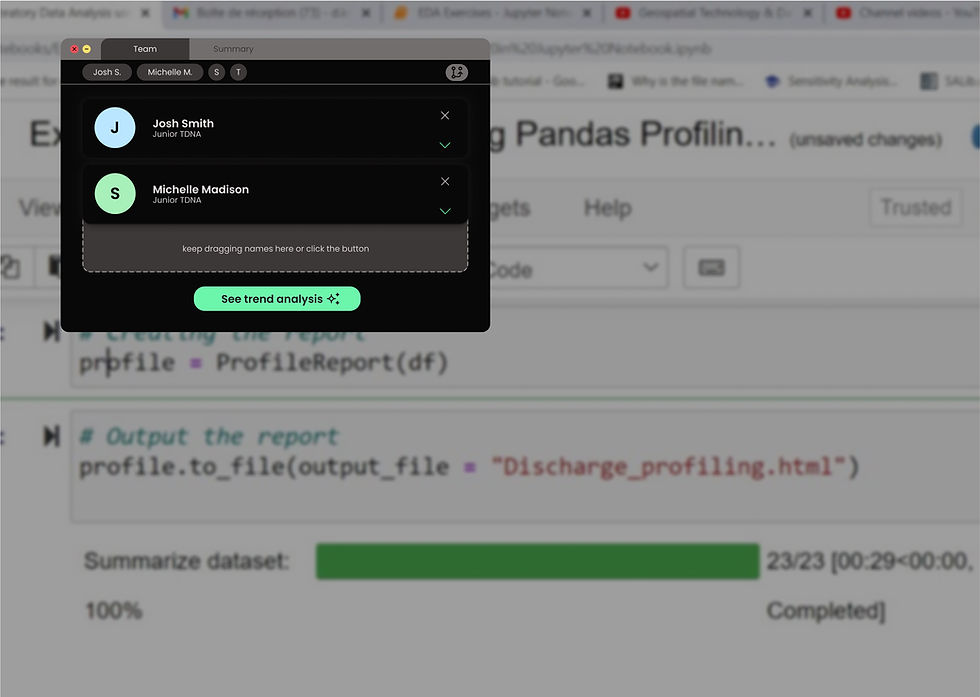
Spine
Spine is a NSA-sponsored Data Synthesis support system that helps Target Network Digital Analysts at Language and Analytical Sciences to query, generate reports and draw connections between data for suspicious activity through wifi and cellular networks. Spine uses Large Language Models and Generative AI and outlier detection to synthesize the anomalies in network detection software.
Role
UX Research
Design Stratagy
UI Design
SPINE
Spine is a generative AI project sponsored by LAS to support Target Digital Network Analysts in solving day-to-day intelligence challenges. It is a monitoring and tradecraft visualization tool designed to assist analysts in sense-making while performing intelligence tasks.
Skills
UX research
UI Design
Component building
System design
Team mates
Parinta Das
Olha Novikova
Year
May 2024
My role:
As a UX researcher and designer, I have extensively researched on existing sensor and digital twin capabilities to design a seamless interface
Scenario
In 2019, a bombing killed two people and injured several others in Macondo, a mountain town in Oceania. A commercially made drone fitted with an IED targeted a coffee shop on North Duke Street during the morning of April 10th, 2019.
Inside Kaffeinate, a local coffee shop, two employees and the owner were preparing for the busy morning rush when the explosion occurred, killing all three. A third employee succumbed to injuries two weeks later, and at least five others, including a firefighter, were injured. The Macondo community was left devastated by the attack.
The blast destroyed the coffee shop and damaged nearby buildings. Initially, the explosion was believed to be caused by a natural gas leak, but as intelligence from the scene emerged, evidence pointed to a deliberate attack, likely carried out by the Republic of Zendia. Leaders of Oceania immediately sought assistance from the Big Government Intelligence Agency (BGIA) to analyze the bombing and guide a national response.
BGIA’s Counterterrorism team is tasked with providing accurate, actionable intelligence on incidents like the Macondo bombing. Their role is to piece together the events before, during, and after the attack to inform Oceania’s leadership and ensure the public receives timely, reliable information.
Problem statement
Being a target network digital analyst involves a lot of intelligence problem solving and analytical thinking. It also involves contextualizing data,desparate data sets, esoteric tradecraft, multiple analytical tools, and non linear learning and complex compliance rules which makes their job harder. Having an ubiquitous collaborative intelligence tool that can understand and contextualize data, enforce complaince warnings and help in monitoring the team's progress can help synthesize multiple types of data related to a particular case and help a TDNA in sensemaking .
Since the current analytical software used in Tradecrafting by TDNA's and process of sensemaking is confidential, We crafted a set of questions that are not intrusive but detailed enough to understand the painpoints in the day to day life of a TDNA.
Compatitive Analysis
Spine is a NSA-sponsored Data Synthesis support system that helps Target Network Digital Analysts at Language and Analytical Sciences to query, generate reports and draw connections between data for suspicious activity through wifi and cellular networks. Spine uses Large Language Models and Generative AI and outlier detection to synthesize the anomalies in network detection software.

Persona
Miguel is a senior Target Digital Network analyst at BGIA.His daily work deals with understanding current intelligence topics worked by BGIA’s Zendian Office as well as acquiring access to data to meet the intelligence needs.His work can cover a wide range of data types and priorities frequently change as events occur. Miguel plans and oversees his team’s activities, but is not a supervisor.

We have conducted multiple sensemaking sessions by ourselves by combined the insights from the user interviews and competitive analysis of various network analytical and threat intelligence tools to understand different parts of a tradecrafting process in a day of a senior TDNA.

We were instructed to develop 3 different ways a software can be used with 3 different features to solve painpoints related to our team specific brief. We started making making low-fidelity wireframes.




Initial layouts:


Mid-Fi wireframes:










Hi-Fi wireframes:
Final video:
We integrated our User Journey and high-fidelity prototypes to create a video showcasing the various features and capabilities of Orchid.

Break down of features



Design Components:


Impact
-
Enabled assistive querying by leveraging LLMs to replace traditional programming, making data access intuitive and inclusive for non-technical users.
-
Automated 100% of daily report documentation by generating insights in real-time, streamlining knowledge sharing and reducing manual overhead.
-
Reduced cognitive load in task management by implementing goal-setting frameworks that enhanced clarity and minimized errors among junior TDNA team members.
-
Enhanced data interpretation through Spine-powered visualizations, helping TDNA professionals understand contextual relationships in data points—making the tradecrafting process more intuitive, efficient, and rewarding.

